
20-30 minutes exposure to direct sunlight can combat
vitamin D deficiency
I’ve worked in the landscape industry for twenty years now. I’ve seen first hand how getting out in the landscape can make you healthier. There are many things you can do to improve your health and help you live longer that don’t involve strenuous exercise, or expensive gym memberships and equipment. So if you’re looking to lose weight, lower cholesterol, reduce stress, feel happier, sleep better, or feel more energised; read on. I’ll share with you some simple things that are backed up by science, that you can do today to benefit your health.
Vitamin D and Vitamin D Deficiency

It’s that time of year again. Every year there is a lot of hype in the media regarding Vitamin D deficiency. This common disorder affects many people in more northern latitudes, such as the UK and Finland, and causes a range of symptoms from lethargy and fatigue, to general aches and pains. It can even cause rickets in children, through the impaired absorption of calcium. What you may not realise is that deficiency in vitamin D can be prevented by regular and sustained access to the landscape. That’s right, simply by going outside and exposing your skin to sunlight you can ‘make’ your own vitamin D.
Vitamin D is synthesised in the skin when directly exposed to ultra-violet radiation from the sun (specifically UVB rays). Whilst there is a small amount of vitamin D in some animal-based foods, such as milk, eggs, and oily fish; the majority of vitamin D in humans is made within the body, using sunlight.
The Effects of Low Vitamin D
According to scientists at Newcastle University patients in a study who were low in vitamin D showed poor muscle recovery after exercise, and experienced fatigue more quickly than when they were treated for vitamin D deficiency.
As the evenings get darker in winter there are fewer hours of sunlight available to create vitamin D. Added to this, in northern parts of the world, during winter, the angle of the sun hitting the earth is such that the quality of the light is too poor to assist in generating vitamin D. According to some sources people living further north than Birmingham in the UK would seriously struggle to make enough vitamin D for the 5 darkest months of the year. For people living in Finland (like me), that period is even longer. However, there is some good news! Vitamin D can be made in the summer and used all year round (to some degree).
Get Outside in the Summer to Stay Healthy All Year
For those of us living at such northerly latitudes, it is recommended that we get a minimum of 20-30 minutes exposure to direct sunlight on the face and forearms 2 to 3 times a week during mid-day in the summer. This should ensure that we have built up enough of a reserve to last through the darker months. Such activities might include yoga or tai chi in your local park during a lunch hour, or visiting an open garden – such as a National Trust property in the UK, or simply eating your lunch al fresco.
Natural Light and Circadian Rhythms
Natural light is not only good for Vitamin D but can enhance your mood and stimulate your circadian rhythms too. This article shows that people who were exposed to blue wavelength light were more alert at work, and felt less tired during the day. They also reported sleeping better during the night.
A Walk in the Park Can Help with Mental Health and Well-being
I know it’s not always easy to schedule enough time to go for a walk, but it might just do you the world of good! There are several things you can do to make time for a quick stroll. For people who commute, this might mean getting off the train or bus a few stops earlier. In this article, scientists monitored participants with mobile electroencephalography (EEG) machines. They found that brain activity changes drastically when people were in green open space when compared to busy shopping streets, or office buildings. The results showed that participants had lower levels of anxiety and arousal and higher levels of meditation when in green spaces. Therefore access to urban green space can contribute to contracting stress, and promote a happier state of mind.
It is important to plan your route through GREEN space. Look out for Green Infrastructure routes or green corridors such as the Cuckoo Trail in Sussex, England. Alternatively, plan your route to pass through at least one park.

The Perfect Antidote to a Hectic Modern Lifestyle?
Urban parks play a vital role in our collective well-being. A study by Dr Mathew White of the University of Exeter draws on 18 years of data (including 10,000 participants), to conclude that living near green public open space significantly contributes to our mental well-being. The study shows that while the effects of urban living on the individual scale might be small, at a population-wide scale the effects might well be greater and that the positive effects of urban green space on mental health should be factored into spatial and health policy planning.
Walking Your Way to Lower Cholesterol
An estimated six to seven million people in the UK take statins every day to lower their cholesterol. There is some growing research that in some cases cholesterol may be able to be managed with the appropriate diet and exercise regime. In his book ‘The New 8 Week Cholesterol Cure: The Ultimate Programme for Preventing Heart Disease’ Robert E. Kowalski discusses the effect walking can have on cholesterol levels in the body. It is worth reading for anyone who is concerned about their cholesterol (or that of a loved one). Of course, before embarking on any new exercise regime, or altering drug treatment, it is vital to seek professional medical advice.
Negative Ions Produce Positive Moods
Even without exercising, being outside can have positive effects on your health and well-being. Electrical equipment in our homes and offices produce positive ions. Ions are molecules that have gained or lost electrons to produce a positive or negative charge. It is negative ions that are the heroes of health. Sadly, these are often few and far between in our urban environments. However, natural environments, such as beaches, waterfalls, and mountains contain these negative ions in their thousands, if not millions. The positive effects of breathing in negative ions include increasing the levels of serotonin (the happy neurotransmitter) in the brain. This can lead to reduced symptoms of depression. And remember, this is just by being outside.

Landscape Architecture Can Make You Healthier
Without landscape architects to design and promote our urban green spaces, like parks and urban greenways, we would not be able to benefit from all that access to green space has to offer. So if you’re looking to combat your stress levels, head to the park. If you want to lose weight, naturally lower your cholesterol, and feel more energised, go for a walk in the park or along a greenway. If you want to beat the winter blues, stock up on the sunshine in the summer through sunbathing in the park or at the beach. And if you want to combat depression, why not add a visit to the beach or mountains into your recovery programme?
